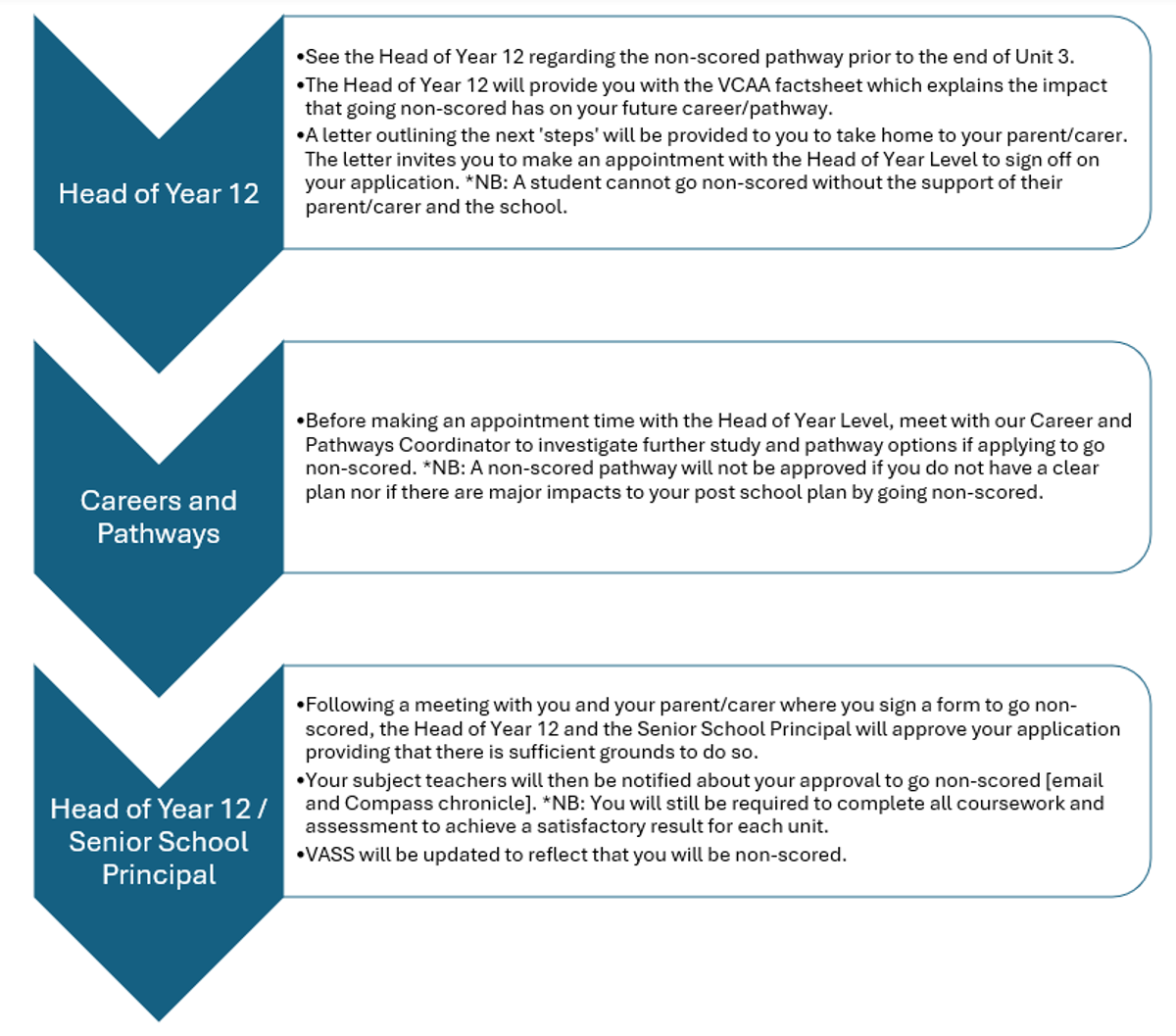Scored vs. Non-Scored VCE

The successful completion of outcomes for all VCE students is based on teacher judgement. In order to satisfy these outcomes, students need to demonstrate the knowledge and skills determined by their subject’s Study Design, and show evidence of their learning to inform this teacher judgement.
Students completing a scored VCE will sit School Assessed Coursework (SACs) and School Assessed Tasks (SATs) as well as the Victorian Curriculum and Assessment Authority (VCAA) end of year examinations, in order to determine their subject’s study score. However, whilst non-scored students complete SACs and SATs to demonstrate their achievement of outcomes, no score is reported to the VCAA.
Students at Norwood Secondary College are expected to complete a scored VCE in order to increase their opportunities and pathways for further education and training.
*NB: Regardless of whether a student is scored or non-scored, they must meet the coursework requirements as well as the minimum attendance requirement (90%) in order to achieve a satisfactory result for any unit of study.
What is a VCE Study Score?
A student’s SAC and SAT scores, as well as final exam score, are used to calculate the final study score for each subject studied. The Victorian Tertiary Admissions Centre (VTAC) uses this score to calculate the student’s ATAR (Australian Tertiary Admissions Rank).
A student’s final study score reveals how a student performed compared with other students that also undertook the study. The maximum study score is 50. The mean study score is 30 for each study, every year. If a student achieves a score of 38 or above, it means that they are in the top 15% of students in the study, while a score between 23 and 37 indicates that the student is in the middle range.
Students must complete two or more ‘graded’ assessments within the study and receive a satisfactory result for both Units 3 and 4 in the same calendar year, in order to receive a study score.
To ensure that School-Assessed Coursework is comparable between schools, statistical procedures are applied by the VCAA to each cohort of students at every school that is undertaking that specific study. The statistical moderation process aligns assessments to the same standard, but the student’s ‘rank order’ as determined by the school is maintained.
What is an ATAR Score?
The Australian Tertiary Admissions Rank (ATAR) measures a student’s overall academic achievement against other Australian students in their final year of schooling. It is important to note that it is a rank and not a score out of 100.
Once students have completed their VCE, the Victorian Tertiary Admissions Centre (VTAC) calculates ATAR scores. VCE results that have been released by the VCAA are used to calculate this score.
It is VTAC that notifies the student of their final ATAR score. If a student has applied for further study, VTAC then sends the student’s ranking and any applications to the relevant tertiary institutions. The ATAR score, along with other course requirements (i.e. pre-requisite subjects) are used to determine if the student is eligible for a specific university or TAFE course.
How is the ATAR Score Calculated?
The ATAR is calculated based on up to six VCE scaled study scores. A study score can be scaled up or down by VTAC depending on the performance of students in a study in a particular year. Hence, scores can change from year to year making an ATAR hard to predict.
Calculated from an aggregate, the ATAR is produced by adding together:
- The student’s scaled study score in English, English as an Additional Language (EAL), English Language or Literature
- The student’s scaled study scores for three additional studies, and
- 10% of the scaled study scores for the fifth and sixth studies
Students are then ranked in order of their aggregate and from this, a percentage rank is assigned in order to distribute students over a 100-point scale. It is the percentage rank that is converted to the student’s ATAR score. The final ATAR score is an estimate of the percentage of the population that a student has outperformed. Thus, if a student achieves an ATAR score of 60, then this indicates that the student has performed better than 60% of students in that academic year.
The ATAR score is a number from 0 to 99.95 with intervals of 0.05. The highest possible ATAR score is 99.95, the next highest being 99.90 and so on. The lowest possible ATAR rank is 30.00. Any ranks below 30.00 are reported as ‘less than 30.’
NSC Process for a Non-Scored
VCE Units 1 & 2:
There is no non-scored VCE pathway for students in a Unit 1 and 2 study. Students are expected to complete all outcomes as determined by the subject’s Study Design in order to satisfactorily complete a unit. School Assessed Coursework and any other subject requirements must be completed to inform teacher judgements and determine satisfactory completion.
VCE Units 3 & 4:
Students who are approved to undertake a non-scored pathway must still complete all outcomes and subject requirements as specified by the subject’s Study Design and to achieve a satisfactory result for a unit. However, if this pathway has been approved, the student is not required to complete the external end of year examinations that contribute to a study score. Once a student’s non-scored pathway has been determined in Unit 4, there may be some degree of flexibility in the delivery of SACs and SATs, and the materials permitted for the assessment i.e. use of a textbook.
A student may be eligible for a non-scored pathway if:
- their career pathway does not require them to have a study score or ATAR
- they have a diagnosed medical condition which impacts their ability to complete formal exams
By undertaking a non-scored pathway, your decision will result in:
- not receiving an ATAR – *NB: scores for Unit 3 and 4 assessment will not be provided to VCAA and your results will read as ‘NA.’
- limited further study options, particularly in tertiary education
Students applying to complete a non-scored pathway must complete the following:
The above mentioned process must be finalised before the end of Term 3 in the lead up to the exam period.

